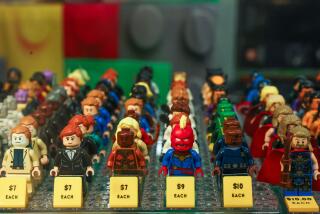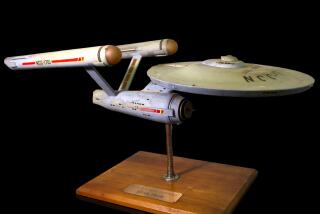Spoils of Gulf War Surface on U.S. Shelves
For $35, a military surplus dealer in Mississippi is selling, straight from the battlefield and freshly deloused, Iraqi army shirts--just like Saddam Hussein’s. Toss in another $10 and he will mail out a genuine Republican Guard beret to match.
How about a captured Iraqi night-vision telescope? A Michigan merchant is offering them at $2,000 each. He did have Iraqi compasses at $100 apiece but they sold out within days.
Interested in a set of combat photographs--including shots of dead Iraqi troops? Thirty-five dollars buys 35 photos from a military hobbyist in Florida.
Such are the souvenirs and spoils of war that have surfaced nationwide in the months after the vanquishing of Iraq.
While American ground troops may have spent little time actually fighting Iraqis, some soldiers apparently had ample opportunity afterward to scavenge enemy bunkers and trenches for personal remembrances--as well as profit.
Hundreds of pieces of Iraqi equipment brought home as trophies have since made their way to military memorabilia dealers who hope to turn a fast buck and to collectors who are speculating that the value of Gulf War booty, like fine wine, will mature with age.
“It’s all supply and demand,” said Michael Mesmer, 48, an engineer and avid military collector from Ft. Myers, Fla. “There’s a very big market for this kind of stuff and not a lot of it out there.”
Among the scarcest items and, perhaps, in greatest demand are captured firearms. American troops were restricted from bringing home enemy rifles and pistols, and at least eight soldiers have been court-martialed thus far for attempting to smuggle enemy pistols and rifles into the United States.
Military surplus dealer Jack Brannon of Southaven, Miss., may not have any weapons from Iraq for sale these days, but he is offering just about everything else.
One of his former employees, a sergeant with the 82nd Airborne Division, shipped Brannon 100 used Army food cartons crammed with 1,600 pounds of enemy equipment and uniforms, he said. The sergeant, according to Brannon, sent back another 2,400 pounds of Iraqi souvenirs for himself and stashed it in his grandfather’s barn south of Memphis.
“When he gets out (of the Army) in 10 or 12 years,” Brannon said, “it’s going to be worth a fortune.”
Brannon, on the other hand, has no intention of keeping his Iraqi inventory for investment purposes. He and several of his competitors have been advertising in publications such as Gun Week, Soldier of Fortune and the Shotgun News, hawking everything from Iraqi army shaving mugs to hardtack ration crackers and leaflets urging the Iraqis to surrender.
Brannon said he started out with a six-page price list of Iraqi equipment. The desert ponchos went quickly. So did the camouflaged helmet covers.
The list is down to four pages. Still for sale are Iraqi army helmets, uniforms, berets, packs, canteens, suspenders, razors, medical bandages (unused) and even boot polish, among other goods.
“All the clothes, I had to get cleaned,” Brannon complained. “They had a lot of lice and fleas on them. . . .”
Andy Kendall’s stock of Iraqi equipment also has dwindled. The Coloma, Mich., surplus dealer has sold the few Iraqi compasses and tunics that he had. He has some trench shovels left along with a handful of infrared telescopes, useful for spotting tanks in the dark.
The only Iraqi items declining in popularity, Kendall said, are Republican Guard patches, of which he bought several hundred from a soldier formerly stationed in the Gulf.
“They’re sucking wind right now,” Kendall said of the patches. “Maybe it’ll turn around.”
Though thousands of Southern California-based military personnel went to the Gulf as part of Operation Desert Storm, few have offered up for sale any Iraqi souvenirs, according to military surplus dealers throughout the region.
Jack Arian, who operates four Supply Sergeant surplus stores in the Los Angeles area, noted that while his company sold more U.S. military surplus equipment during the Gulf Crisis than at any time in the 40-year history of the chain, he believes that most people have grown “disgusted by the war,” especially the fact that Saddam Hussein survived it.
“If somebody offered me items from Iraq,” Arian said, “I’d probably throw it in the trash.”
Other local surplus dealers, however, said they consider Iraqi souvenirs a marketable commodity.
“If I could get my hands on it,” said George Telson of Merchants World Surplus Enterprise in Vernon, “I’d buy it up in a minute. The problem is getting your hands on it.”
Collector Richard Johnson, 37, of Titusville, Fla., estimated that there may be as many as 1,000 hard-core military hobbyists throughout the United States earnestly scouring garage sales, gun shows and surplus stores for Iraqi equipment.
“Helmets are a decent investment,” Johnson said. “I can see them doubling in five years. Camouflaged uniforms--only maybe 5% of the Iraqis had camouflage--I can see them maybe tripling in price.”
Plastic Iraqi canteen cups may have value, he said, because of their relative rarity: Most were destroyed by Iraqi troops who filled them with kerosene and used them as candles.
Johnson, a computer programmer for McDonnell Douglas, which builds Cruise missiles like those fired at Iraqi targets, has so far accumulated more than a dozen Republican Guard uniforms, half a dozen helmets, surrender leaflets, an ammunition compartment for a Russian-made machine gun and, his most prized acquisition: a diary-like handbook that belonged to a platoon leader from a Republican Guard commando unit.
“This guy wrote everything down,” Johnson marveled, “even the blood types of each of his men.”
Johnson is still shopping for an Iraqi combat map--considered valuable because coalition intelligence officers are believed to have seized most, if not all, of the maps that were printed.
According to U.S. Central Command regulations, American troops were permitted to keep as war trophies any enemy clothing and individual equipment they found, so long as it did not belong to Iraqi prisoners of war. The taking of captured firearms was forbidden--but that did not stop some from trying.
A lieutenant colonel with the 24th Infantry Division (Mechanized) based at Ft. Stewart, Ga., was recently court-martialed after three Iraqi AK-47 automatic rifles were found in his footlocker.
The officer argued that he had brought the guns home to be displayed in his battalion’s museum. He was stripped of command of his unit, given a letter of reprimand and docked one month’s pay.
In July, three Arkansas National Guardsmen were similarly court-martialed at Ft. Sill, Okla., and found guilty of attempting to smuggle back from the Persian Gulf 13 AK-47s and 10 Iraqi pistols. The firearms were discovered in an Army truck being loaded aboard a ship in Saudi Arabia that was bound for the United States.
The guardsmen were demoted, fined and placed on 60 days’ restriction. Five other enlisted men implicated in the plot also were demoted and fined.
Nonetheless, rumors abound within the small world of military collectors that with more than 400,000 troops having served in the Middle East, more than a few came back with captured firearms.
“You weren’t supposed to come back from Vietnam with (enemy weapons) either,” observed one collector who has bought and sold contraband guns from Vietnam, “but a lot of people did.”
It is only a matter of time, he and others believe, before Iraqi AK-47s and other guns turn up on merchants’ shelves.
If firearms from the Gulf War are considered rare, so too are quality combat photographs, collectors say. So few pictures have surfaced that some dealers and collectors believe the photos themselves are a sound investment.
Collector Johnson, for example, bought a roll of battlefield film shot by an infantryman and is selling 35 photos for $35. Some of the pictures, Johnson says, are of “fried Iraqis.”
“People want to see captured and dead enemy,” said Johnson, who served as an Army sergeant in Vietnam. “Most can’t experience war themselves and have no idea of the horror of war. If more truehearted people could see these pictures, there’d be fewer pictures like these.”
More to Read
Sign up for Essential California
The most important California stories and recommendations in your inbox every morning.
You may occasionally receive promotional content from the Los Angeles Times.










